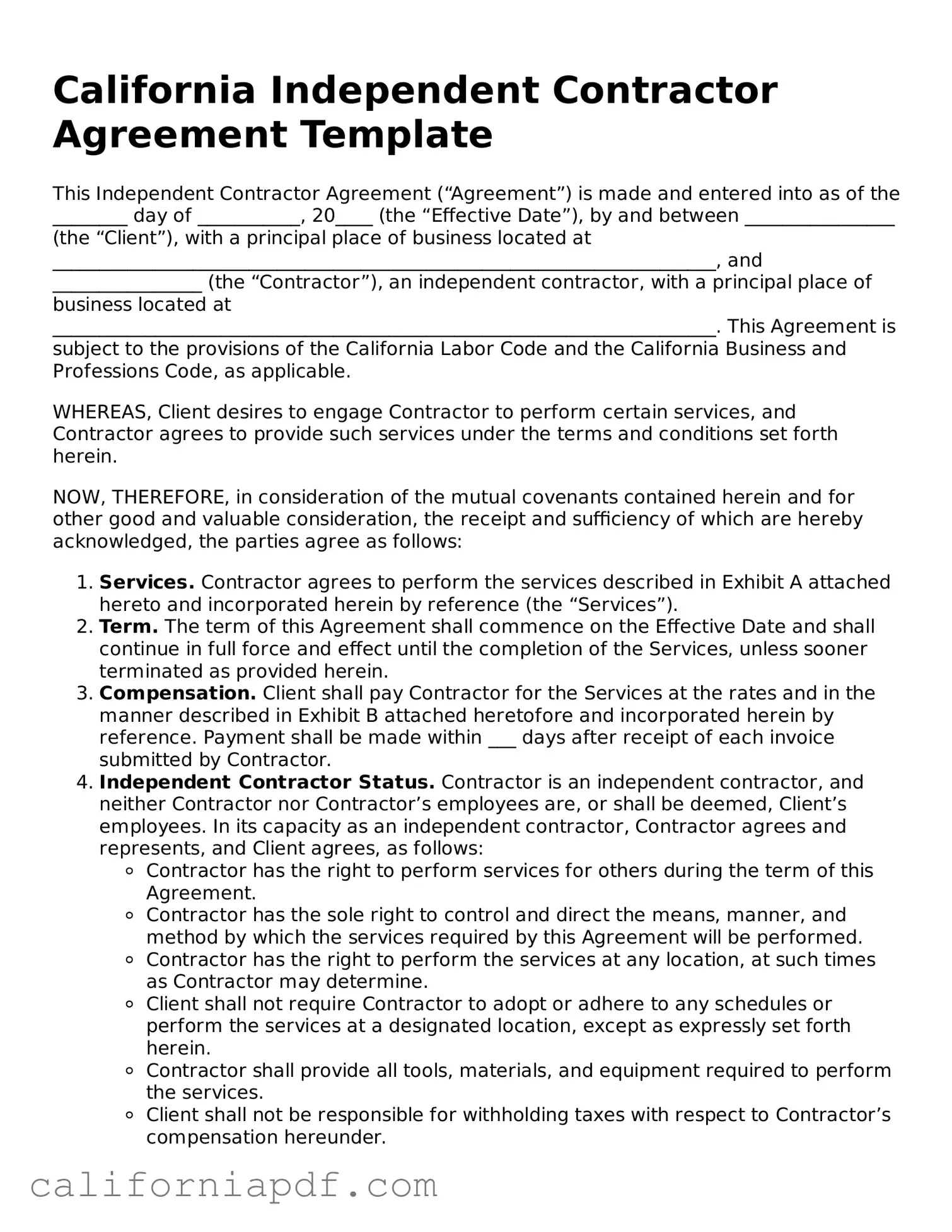California Independent Contractor Agreement Template
This Independent Contractor Agreement (“Agreement”) is made and entered into as of the ________ day of ___________, 20____ (the “Effective Date”), by and between ________________ (the “Client”), with a principal place of business located at _______________________________________________________________________, and ________________ (the “Contractor”), an independent contractor, with a principal place of business located at _______________________________________________________________________. This Agreement is subject to the provisions of the California Labor Code and the California Business and Professions Code, as applicable.
WHEREAS, Client desires to engage Contractor to perform certain services, and Contractor agrees to provide such services under the terms and conditions set forth herein.
NOW, THEREFORE, in consideration of the mutual covenants contained herein and for other good and valuable consideration, the receipt and sufficiency of which are hereby acknowledged, the parties agree as follows:
- Services. Contractor agrees to perform the services described in Exhibit A attached hereto and incorporated herein by reference (the “Services”).
- Term. The term of this Agreement shall commence on the Effective Date and shall continue in full force and effect until the completion of the Services, unless sooner terminated as provided herein.
- Compensation. Client shall pay Contractor for the Services at the rates and in the manner described in Exhibit B attached heretofore and incorporated herein by reference. Payment shall be made within ___ days after receipt of each invoice submitted by Contractor.
- Independent Contractor Status. Contractor is an independent contractor, and neither Contractor nor Contractor’s employees are, or shall be deemed, Client’s employees. In its capacity as an independent contractor, Contractor agrees and represents, and Client agrees, as follows:
- Contractor has the right to perform services for others during the term of this Agreement.
- Contractor has the sole right to control and direct the means, manner, and method by which the services required by this Agreement will be performed.
- Contractor has the right to perform the services at any location, at such times as Contractor may determine.
- Client shall not require Contractor to adopt or adhere to any schedules or perform the services at a designated location, except as expressly set forth herein.
- Contractor shall provide all tools, materials, and equipment required to perform the services.
- Client shall not be responsible for withholding taxes with respect to Contractor’s compensation hereunder.
- Confidentiality. During the term of this Agreement and thereafter, Contractor agrees to take all reasonable steps to maintain the confidentiality of Client’s proprietary information and not to disclose such information to any third party without the prior written consent of Client, except as may be necessary to perform the Services under this Agreement.
- Termination. Either party may terminate this Agreement at any time upon ___________ days’ written notice to the other party.
- Governing Law. This Agreement shall be governed by and construed in accordance with the laws of the State of California, without regard to its conflict of laws principles.
- Entire Agreement. This Agreement contains the entire understanding and agreement between the parties and supersedes any and all prior or contemporaneous oral or written communications regarding the subject matter hereof. Any changes to this Agreement must be in writing and signed by both parties.
IN WITNESS WHEREOF, the parties have executed this Agreement as of the Effective Date.
Client: ___________________________________
Contractor: _______________________________
